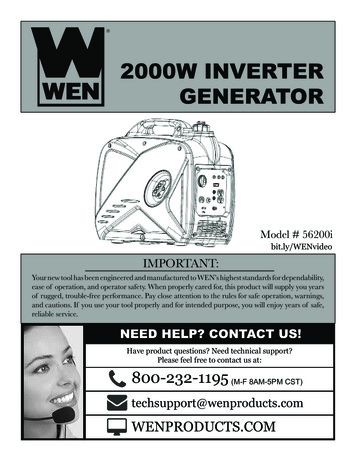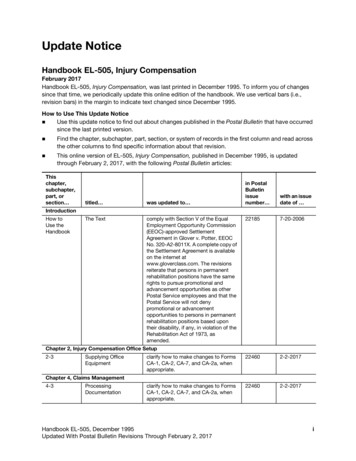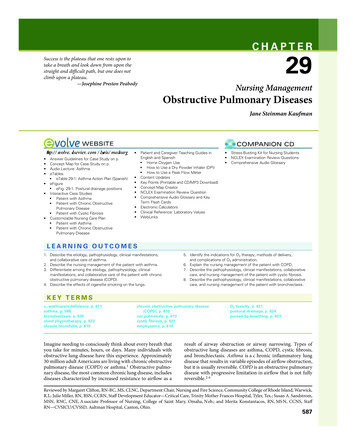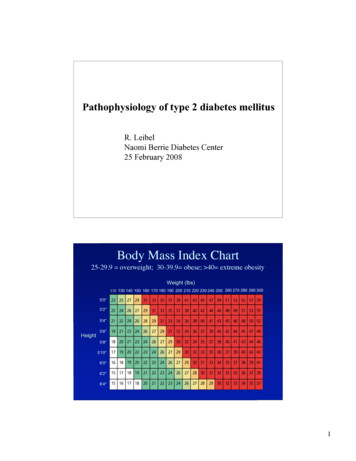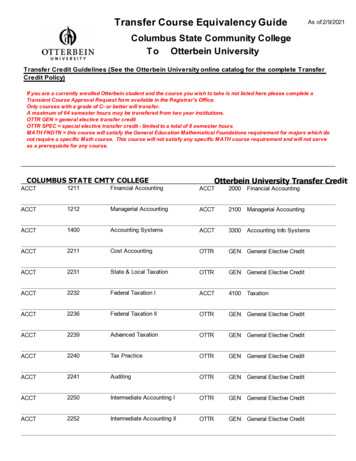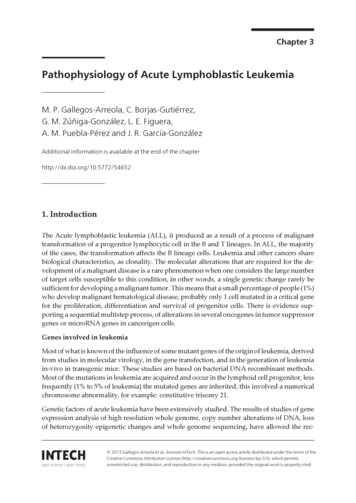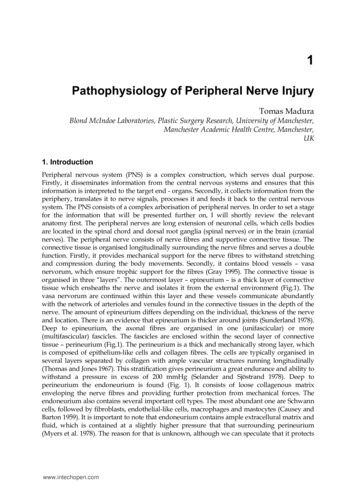
Transcription
1Pathophysiology of Peripheral Nerve InjuryTomas MaduraBlond McIndoe Laboratories, Plastic Surgery Research, University of Manchester,Manchester Academic Health Centre, Manchester,UK1. IntroductionPeripheral nervous system (PNS) is a complex construction, which serves dual purpose.Firstly, it disseminates information from the central nervous systems and ensures that thisinformation is interpreted to the target end - organs. Secondly, it collects information from theperiphery, translates it to nerve signals, processes it and feeds it back to the central nervoussystem. The PNS consists of a complex arborisation of peripheral nerves. In order to set a stagefor the information that will be presented further on, I will shortly review the relevantanatomy first. The peripheral nerves are long extension of neuronal cells, which cells bodiesare located in the spinal chord and dorsal root ganglia (spinal nerves) or in the brain (cranialnerves). The peripheral nerve consists of nerve fibres and supportive connective tissue. Theconnective tissue is organised longitudinally surrounding the nerve fibres and serves a doublefunction. Firstly, it provides mechanical support for the nerve fibres to withstand stretchingand compression during the body movements. Secondly, it contains blood vessels – vasanervorum, which ensure trophic support for the fibres (Gray 1995). The connective tissue isorganised in three “layers”. The outermost layer – epineurium – is a thick layer of connectivetissue which ensheaths the nerve and isolates it from the external environment (Fig.1). Thevasa nervorum are continued within this layer and these vessels communicate abundantlywith the network of arterioles and venules found in the connective tissues in the depth of thenerve. The amount of epineurium differs depending on the individual, thickness of the nerveand location. There is an evidence that epineurium is thicker around joints (Sunderland 1978).Deep to epineurium, the axonal fibres are organised in one (unifascicular) or more(multifascicular) fascicles. The fascicles are enclosed within the second layer of connectivetissue – perineurium (Fig.1). The perineurium is a thick and mechanically strong layer, whichis composed of epithelium-like cells and collagen fibres. The cells are typically organised inseveral layers separated by collagen with ample vascular structures running longitudinally(Thomas and Jones 1967). This stratification gives perineurium a great endurance and ability towithstand a pressure in excess of 200 mmHg (Selander and Sjöstrand 1978). Deep toperineurium the endoneurium is found (Fig. 1). It consists of loose collagenous matrixenveloping the nerve fibres and providing further protection from mechanical forces. Theendoneurium also contains several important cell types. The most abundant one are Schwanncells, followed by fibroblasts, endothelial-like cells, macrophages and mastocytes (Causey andBarton 1959). It is important to note that endoneurium contains ample extracellural matrix andfluid, which is contained at a slightly higher pressure that that surrounding perineurium(Myers et al. 1978). The reason for that is unknown, although we can speculate that it protectswww.intechopen.com
2Basic Principles of Peripheral Nerve Disordersendoneurial space from possible contamination by toxic substances external to the epineuralspace.Fig. 1. Ultrastructure of the peripheral nerve.(a) Toluidine blue stained transverse section through peripheral nerve of rat.(b) Detail on thick epineurium enveloping the nerve(c) Detail on area with peri- and endoneurium.www.intechopen.com
Pathophysiology of Peripheral Nerve Injury3When talking about the injury to the nervous system, it is essential to consider all parts ofthis system and also end organs, which are dependent on it. Thus, this review will focusseparately on neural cells, sensory organs and muscle.1.1 Response of the neural cellsThe damage to the neural cells is the most obvious consequence of the injury to theperipheral nerve. As mentioned above, the nerve is essentially a multi-strand cord-likestructure, which keeps the nerve fibres organised and protected from the external forces.With the cell bodies being located in the spinal cord and dorsal root ganglia, all the injuriesto the nerves are happening at the level of cellular processes – axons. Perhaps the onlyexception to this statement is roots avulsion from spinal cord, for example during brachialplexus injury. The nerve injury divides neurons into a part, which is proximal and a part,which is distal to the injury site. These two parts differ significantly from each other, as faras the reaction to the injury is concerned.1.1.1 Distal to the injury site (Wallerian degeneration)More than 160 years have passed since the first report describing the reaction of distal nervestump to axotomy. The original work was performed by Augustus Waller and waspresented to the Royal Society of London in 1850. Waller was studying injuries toglossopharyngeal and hypoglossal nerves in frogs. It is obligatory to quote an excerpt fromhis original report here (Waller 1850):“During the four first days, after section of the hypoglossal nerve, no change is observed inits structure. On the fifth day the tubes appear more varicose than usual, and the medulla(term used to describe axons) more irregular. About the tenth day medulla formsdisorganized, fusiform masses at intervals, and where the white substance of SCHWANNcannot be detected. These alterations, which are most evident in the single tubules, may befound also in the branches. After twelve or fifteen days many of the single tubules haveceased to be visible, their granular medulla having been removed by absorption. Thebranches contain masses of amorphous medulla.”This process of disintegration of distal axonal stump after injury is termed Walleriandegeneration. It is a recognized consequence of a mechanical (but not only) insult to thenerve. Wallerian degeneration starts almost immediately after axotomy and lasts 3 – 6 weeks(Geuna et al. 2009). The first sign is disintegration of axons, which starts during first 24 to 48hours (Stoll et al. 1989). The beginning of this process is characterised by granulation withinaxoplasma caused by proteolysis of microtubules and neurofilaments (Lubińska 1982,Schlaepfer 1977). This is caused by a rapid activation of axoplasmatic proteolyses, whichoccurs as a response to intracellular calcium influx (George, Glass, and Griffin 1995,Schlaepfer and Bunge 1973). An early activation of ubiquitin-proteasome system has beenalso shown to play an important role here (Ehlers 2004). Among all the cytoskeletalstructures, the microtubules are thought to disintegrate first (Watts, Hoopfer, and Luo 2003,Zhai et al. 2003). The loss of microtubular structures then leads to impediment of axonaltransport and further accelerates the degeneration process. The disintegration ofneurofilaments follows shortly and is usually completed within 7 – 10 days. During thistime, the partially disrupted neurofilaments can be detected in the axoplasma only towww.intechopen.com
4Basic Principles of Peripheral Nerve Disorderscompletely disappear shortly afterwards. One more important point, which needs to bemade, is the direction of the Wallerian degeneration. It seems that the process isbidirectional. It starts in the zone just below the injury and progresses distally while at thesame time starts at the distal axonal termini (Waxman 1995). Despite the very brisk initiationof degenerative changes, the distal nerve stump preserves its excitability for a considerableperiod of time. When the transacted axons are stimulated distal to the injury zone, it is oftenpossible to record nerve potentials for up to 10 days. Therefore, it is very important for thisperiod of refractory excitability to finish, before accurate estimate of the nerve injury extentcan be made by electrophysiological methods.The processes, which we have discussed so far, were limited to the axon and its inherentability to degenerate after injury. To have the full picture of the Wallerian degeneration, wealso need to talk about other cells, which participate and play an integral role in it. Inparticular, the role of Schwann cells and macrophages is critical for the Walleriandegeneration to take place. The Schwann cells are very sensitive to the loss of contact withaxon. In case of dennervation, the Schwann cells change from “supportive” to “reactive”phenotype. They stop producing myelin (LeBlanc and Poduslo 1990). The continuingproliferation of Schwann cells leads to formation of Bands of Bungers, which purpose isthought to be guidance of the regrowing axons (further discussed in the regenerationsubchapter) (Liu, Yang, and Yang 1995). It seems that this phenotypic switch is, at leastpartly, a response to neuregulin secretion from the transacted axons (Esper and Loeb 2004).Activated Schwann cells were found to secret a wide range of immunologically activesubstances. In particular, Interleukin (IL) -1B, IL – 6, IL – 10 and Leukaemia InhibitoryFactor (LIF) were detected abundantly at the injury site in the first few days after injury(Bolin et al. 1995, Jander et al. 1996, Jander and Stoll 1998, Kurek et al. 1996). Thesesubstances are responsible for attracting immune cells into the distal nerve stump andorchestrating their function. It was shown, that in the first two days after nerve injurymacrophages and T cells start to infiltrate injury zone, which culminates in infiltration of theentire distal stump by day 4 (Brück 1997, Perry, Brown, and Gordon 1987). They areresponsible for phagocytosis of the axonal debris and myelin sheaths residua released fromthe disintegrating axons and thus finishing the breakdown and elimination of axons.1.1.2 Proximal to the injury site (proximal end degeneration)The immediate consequence of axotomy is partial retraction of the proximal stump (Cajal1928) leaving empty endoneurial tubes lined by Schwann cells. The distance to which theproximal stump retracts is usually one or two nodes of Ranvier, but that depends onseverity and character of injury. Within the same timeframe the injured axons also seal theirinjured axolemma to prevent axoplasma leakage. Shortly after retraction and as early ashours after axotomy, the proximal stump starts to produce regenerative sprouts (McQuarrie1985, Meller 1987, Friede and Bischhausen 1980). While these sprouts are forming the cut tipof the axon swells up, containing endoplasmatic reticulum, mitochondria and microtubules.This swelling contains products accumulating in the tip of the stump because of disruptedanterograde axonal transport. One important event happening in the area of the swelling isreorganisation of microtubular cytoskeleton. In the normal axon the microtubules areorganised longitudinally and all point distally along the axon. After axotomy thearrangement of microtubules changes and they point against each other (Erez et al. 2007).www.intechopen.com
Pathophysiology of Peripheral Nerve Injury5This swelling is very probably giving the basis for development of axonal end-bulbs, whichoccurs within 24 – 48 hours after the injury. The relation between axonal endbulb and axonalgrowth cone remains not fully understood (Goldberg, Frank, and Krayanek 1983). A recentreport suggests that depending on the local environment, the injured axons either formregenerative growth cones or incompetent endbulbs (Kamber, Erez, and Spira 2009). Thesuccessful formation of the growth cone is the ultimate goal of the proximal nerve stump, asthis will be the starting point of the nerve regeneration (see below).1.1.3 Cell body responseThe neurons, which axons were injured and ended up in Wallerian degeneration have lost asubstantial part of their cellular mass. Although we expect them to re-grow their lost partsand re-establish the functional connection with their end organ, the situation is not alwaysso favourable. It seems, that the outcome is influenced by location of the lesion in relation tocell body, type of neuron, physical age and local availability of trophic factors. The mostextreme outcome of nerve axotomy is cellular death of the injured neuron. The proportion ofneuronal cell death in dorsal root ganglia after sciatic nerve lesion in rodents has beenreported to be 10 – 30 % (Ygge 1989, Groves et al. 1997). The number is much lower inmotoneurons, where no significant neuronal death has been observed (Vanden Noven et al.1993). However, the situation is dramatically different if the nerve (or ventral root) has beenavulsed from the spinal chord. In this case the motoneuronal death can be as high as 80%(Martin, Kaiser, and A C Price 1999, Koliatsos et al. 1994).There are several morphological changes in the surviving neurons after axotomy. The mostobvious one is chromatolysis, which is dissolution of the Nissle substance (Cotman 1978,Kreutzberg 1995). The Nissle substance is a synonym for rough endoplasmatic reticulumcontaining mRNA, which has blue and dotty appearance on haematoxylin eosin stain. It isnormally located in the centre of the neuron. The chromatolysis starts within hours of injuryand peaks from 1 – 3 weeks. It usually resolves with reinnervation and the process is moreprolonged and intensified if the distal reinnervation does not occur. The chromatolysisseamlessly continues either to regeneration or to neuronal death (Martin, Kaiser, and Price1999). It is not entirely understood what makes the neuron to initiate chromatolysis. It seemsthat local synthesis of regulatory proteins on the axonal level and their linking to the dyneinretrograde motor are at the start of the process (Hanz and Fainzilber 2006). Another earlyevent after axotomy is swelling of the neuronal body and increase of nucleolar size. Later,the nucleus is displaced under the cell membrane and if the reinnervation does not occur,the neuron undergoes atrophy. One more important morphological change after neuronalinjury is a reduction of dendritic arborisation. This dendritic retraction leads to a decrease ofthe number of synaptic connections of the injured neuron and to a functional isolation of it(Purves 1975, Brännström, Havton, and Kellerth 1992a). There is an evidence themotoneurones rebuild their dendritic complex following the reinnervation of target muscle(Brännström, Havton, and Kellerth 1992b). In contrast, in permanent axotomy this does nothappen (Brännström, Havton, and Kellerth 1992a).Apart from the morphological changes discussed so far, there is also a great shift on thefunctional cellular level. After axotomy, the surviving neurons switch from signaltransmitter “program” to regenerative “program”, or as Fu and Gordon put it from“signalling mode” to “growing mode” (Fu and T Gordon 1997). The survival of the cell andwww.intechopen.com
6Basic Principles of Peripheral Nerve Disordersthe mode switch are the first critical steps taken by the neuron towards regeneration. Theswitch brings changes to protein expression levels in the way that signalling-associatedproteins become downregulated and growth-associated proteins and structural componentsof the cell become upregulated. Gene expression studies have demonstrated changes inexpression patterns of hundreds of genes - the function of many is still yet to be explored(Kubo et al. 2002, Bosse et al. 2006). There seems to be a similarity between these newlyfound expression patterns and protein expression in developing neurons duringembryological development. A group of growth-associated proteins, such as GAP-43 (Skeneet al. 1986), are upregulated during the axonal growth phase up to 100 times and then theirexpression drops down upon reinnervation (Karns et al. 1987, Skene et al. 1986). Also, theexpression of cytoskeletal component genes follows the developmental pattern. Theproduction of neurofilaments gets tuned down (Oblinger and Lasek 1988, Hoffman et al.1987) whereas the production of tubulins steeply increases (Miller et al. 1989, Hoffman andCleveland 1988). Following is the recapitulation of changes in gene expression in the mostimportant gene categories (Navarro 2009). Upregulated genes include: Transription factors (c-fos, c-jun, ATF3, NFkB, CREB, STAT)Neurotrophic factors (NGF, BDNF, GDNF, FGF)Neurotrophic receptors (Trk, Ret, P75)Cytokines (TNFa, MCP1)Growth associated proteins (GAP43)And the downregulated genes are: NeurofilamentsNeurotransmittersPostsynaptic receptorsThis is by no means an exhaustive list, but should serve only as a demonstration of thephilosophy behind gene expression alteration following nerve injury.1.2 Response of the end organs and connective tissuesThe multitude of functions that nerves fulfil is only possible because of a fine-tuned crosstalkbetween the nerve and its end organs. It is important to note here, that the nerve acts merely asan interface between the central nervous system and peripheral organs. Thus, for the nerve tofunction as intended it must be connected to the end organs. The end organs must not onlyfunction properly, but also have to effectively communicate with the nerve. After the nerveinjury this co-dependent communication circuit gets disrupted. If we look at the nerveregeneration as a process of re-establishing this communication, we also need to consider theend organs and their reaction to the nerve injury. This will be in discussed in this subchapter.1.2.1 Response of muscleReaction of the muscle to the dennervation takes place on several levels. The dennervatedmuscle changes its structure and its electrophysiological and biochemical properties. It hasnot been fully explained why these changes occur. It is probably a mixture of inactivity andloss of trophic stimuli from the neurons (Midrio 2006). The principal structural change isatrophy of individual muscle fibres with loss of muscle weight. The weight may decrease towww.intechopen.com
Pathophysiology of Peripheral Nerve Injury7as low as 30% of the muscle original weight (Fu and T Gordon 1995). Under lightmicroscope the muscle fibres form nuclear knots, which are chains of nuclei with very littlesurrounding sarcoplasm. On ultrastructural level we can detect disruption of myofibrils anddisorganisation of sarcomeres. Electrophysiological tests will show decline in CompoundMuscle Action Potential (CMAP), which normally recovers with reinnervation. Duringregeneration the muscle motor units can significantly enlarge. This happens due to collateralsprouting, where one neuron will eventually innervate a higher number of motor platesthen it did originally (Fu and T Gordon 1995). On biochemical level, the dennervatedmuscles show decreased uptake of glucose, impaired binding of insulin, decrease ofintramuscular glycogen and also alteration of glycolytic enzymes (Burant et al. 1984,Donaldson, Evans, and Harrison 1986, DuBois and Max 1983).1.2.2 Response of sensory organsThe response of the sensory organs is much less studied and understood than that of themuscle. A successful reinnervation of cutaneous sensory organs depends of a small subset ofSchwann cells found at the terminal ending of neural fibres. The dennervation of thesensory organs results in the survival of these Schwann cells along with the capsularstructures of sensory organs (Dubový and Aldskogius 1996), which are thought to guide theaxonal regrowth towards their appropriate targets.2. Axonal regeneration after peripheral nerve injuryAs discussed above, the first wave of axonal sprouting occurs as soon as hours afteraxotomy (Fawcett and Keynes 1990, Mira 1984). The transected axons produce a greatamount of terminal and collateral sprouts, which are progressing down the endoneurialtube while being in close contact with the Schwann cells (Nathaniel and Pease 1963, Haftekand Thomas 1968). This first wave of axonal sprouting is followed by a second wave abouttwo days later (Cajal 1928, Mira 1984, Cotman 1978). It has been observed that axons maybranch once they reach the distal stump, where one axon may give rise to several branches(Jenq, Jenq, and Coggeshall 1987, Bray and Aguayo 1974). The early regenerating axons aregrowing in the environment, which contains Schwann cells with their basal lamina,fibroblasts, collagen, immunocompetent cells and axonal debris from degenerating axons.The Schwann cells and their basal lamina play a crucial and indispensable role in the nerveregeneration. It was shown that if the Schwann cells are not present in the distal stump, theregeneration occurs very slowly. This is only thanks to a support of the Schwann cellsmigrating from the proximal stump and accompanying the regenerating axons (Gulati 1988,Hall 1986a). If the migration of the Schwann cells into the distal nerve stump is prohibited(such as by a cytotoxic agent), the axons fail to regenerate completely (Hall 1986b). Asmentioned above, the Schwann cells react swiftly to the loss of axonal contact byproliferation and assisting in breaking down the myelin sheaths. While multiplying, theyalso migrate and align themselves into longitudinal columns called bands of Bungner(Waxman 1995, Duce and Keen 1980, Lundborg et al. 1982). The bands of Bungner arephysical guides for regenerating axons. The axons first grow through the injury zone andthen into the bands of Bungner. In order for the regeneration outcome to achieve the preinjury state, the axons should ideally grow back into their corresponding columns.However, the studies on early behaviour of regenerating axons showed that this is notwww.intechopen.com
8Basic Principles of Peripheral Nerve Disordershappening. Axons send several regenerative sprouts, which can grow in multitude ofdirections and encounter of up to 100 bands of Bungner (Witzel, Rohde, and Brushart 2005).Some of the axons then grow into them, whereas others may grow freely into the connectivetissue of the nerve, or take an extraneural course. In this setting, the choice of finalregeneration pathway becomes only a matter of chance. This process is termed axonalmisdirection and can significantly hamper the regeneration process. If we consider asituation where a motor fiber grows into the pathway belonging originally to a sensoryneuron, this will lead into the failure of functional restoration (Molander and Aldskogius1992, Bodine-Fowler et al. 1997). It seemed, that there was a preferential affinity ofmotoneurons to reinnervate motor pathways (Brushart 1993), although a more recent reportdid not detect any differences in motor against sensory regrowth (Robinson and Madison2004). One way to reduce the misdirection, which is fully in our hands, is a meticuloussurgical technique. It is imperative to use an operating microscope to minimise the impact ofa gross misalignment of nerve stumps.Apart from providing a mechanical guidance for the regenerating axons, the Schwann cells arealso responsible for humoral stimulation of the neuronal outgrowth. The expression of NGF isstimulated in Schwann cells shortly after nerve injury (Heumann 1987). This happens veryprobably as a response to Interleukin-1 secretion by macrophages (Lindholm et al. 1987). Also,the expression of Neurotrophin 3, 4, 5, 6 as well as Brain – Derived Neurotrophic factorsharply increase (Funakoshi et al. 1993). The advancement of axons is further facilitated bygrowth – promoting molecules, such as laminin and fibronectin (Baron-Van Evercooren et al.1982, Rauvala et al. 1989). Several studies also demonstrated positive involvement of adhesionmolecules, such as neural cell adhesion molecule (NCAM), neural – glia cell adhesionmolecule (NgCAM), integrins and cadherins (Walsh and Doherty 1996, Seilheimer andSchachner 1988, Bixby, Lilien, and Reichardt 1988, Hoffman et al. 1986).In case of myelinated axons, myelination starts as early as eight days after the injury. Theremyelination is thought to recapitulate events from the embryonic development. Thetrigger for the start of myelination is axonal radial growth and reaching a certain diameter.In development it is around 2 µm (Armati 2007). The Schwann cells then rotate around theaxon in their endoneurial tube and form a myelin layer around a length of axon, which willcorrespond to an intermodal segment. It is important to note, that there is a constant relationof 1:1 between a number of cells and internodal segments – i.e. one internodal segment isalways myelinated by only one Schwann cell. The internodal segments tend to be shorter inregenerated nerves, in comparison to the developing nerves (Vizoso and Young 1948,Ghabriel and Allt 1977, Minwegen and Friede 1985). This is probably an explanation fordecreased conduction velocity in regenerated nerves (Cragg and Thomas 1964). Theinformation whether the myelination will occur or not is stored in the axons. The Schwanncells have an ability to detect that and selectively myelinate appropriate axons (Aguayo et al.1976, Weinberg and Spencer 1975).3. Classification of nerve injuries3.1 Seddon’s classificationUnder normal circumstances, the nerves remain connected with their innervation targetsduring the whole life of an individual. The most common disturbance to this status quo is awww.intechopen.com
Pathophysiology of Peripheral Nerve Injury9nerve damage by mechanical forces, which results in a loss of ability of the nerve to transferstimuli. These forces can act through compression, traction, laceration and direct injectioninto the nerve. Moreover, the nerve can get damaged by thermal noxae, electric current,radiation and metabolic disorders. As a result of the injury the CNS completely, or partially,looses the ability to communicate with the neural end organs. The extent to which thishappens is greatly variable and depends on the degree of damage to the nerve. The firstclassification of the severity of nerve injury was published by Seddon (Seddon 1943) andwas based on his extensive experience with war victims. He classified the nerve injuries tothree degrees, neuropraxia, axonotmesis and neurotmesis and defined the terms as follows:1.2.3.Neurotmesis describes the state of a nerve in which all essential structures have beensundered. There is not necessarily an obvious anatomical gap in the nerve; indeed, theepineural sheath may appear to be in continuity, although the rest of the nerve at thesite of damage has been completely replaced by fibrous tissue. But the effect is the sameas if anatomical continuity had been lost. Neurotmesis is therefore of widerapplicability than division.Axonotmesis—here the essential lesion is damage to the nerve fibers of such severity thatcomplete peripheral degeneration follows; and yet the epineurium and more intimatesupporting structures of the nerve have been so little disturbed that the internalarchitecture is fairly well preserved. Recovery is spontaneous, and of good quality,because the regenerating fibers are guided into their proper paths by their intactsheaths.Neuropraxia is used to describe those cases in which paralysis occurs in the absence ofperipheral degeneration. It is more accurate than transient block in that the paralysis isoften of considerable duration, though recovery always occurs in a shorter time thanwould be required after complete Wallerian degeneration; it is invariably complete.3.1.1 NeuropraxiaNeuropraxia is a situation where the nerve (or more commonly a segment of it) losses itsability to propagate action potential while the structural continuity of the axons is fullypreserved. The condition is associated with segmental demyelination of the nerve fibers.Because the degree of myelination differs depending on the type of nerve fibers, so does theextent of functional loss and return. The motor fibers are the most susceptible and theirfunction is lost first and regained last, whereas pain and sympathetic fibers are the opposite(Sunderland 1978). Typical example of this type of nerve injury is sleeping with the pressureon the nerve, also called the “Saturday night palsy”. This type of injury usually recoverswithin 12 weeks without any intervention.3.1.2 AxonotmesisAxonotmesis is an injury resulting in the loss of axonal continuity without any damage tothe connective tissue structures within the nerve. Full Wallerian degeneration and axonalregrowth occur here and a Tinnel’s sign accompanies the regeneration. The recovery offunction is usually very good, although not as good as in neuropraxia. Surgical interventionis normally not necessary.www.intechopen.com
10Basic Principles of Peripheral Nerve Disorders3.1.3 NeurotmesisDamage to the neural connective tissue structures, including endoneurium, perineurium and /or epineurium is termed neurotmesis. Again, Wallerian degeneration and axonal regrowthoccur and Tinnel’s sign is possible to elicit over the injured nerve. The regeneration processhere is hampered by axonal misdirection, loss of nerve/blood barrier and intraneural scarring.Injuries interrupting peri- and epineurium require surgical intervention. The outcome isgenerally worse than in axonotmesis. This, however, also depends on the relative locationfrom the innervation target and in general it is difficult to predict.3.2 Sunderland’s classificationEarly work of Sunderland brought about a much deeper understanding of the nerveultrastructure (Sunderland, 1947, Sunderland and Bradley 1949). This offered an explanationfor a wide variety of clinical findings and outcomes in the neurotmesis category. Naturalfollowing of this line of thought was extension of the Seddon’s classification, which wasformalised by Sutherland (Sunderland 1978). In the new classification the types I and IIcorrespond to neuropraxia and axonotmesis respectively. Type III is an injury involving axonsand endoneurium while perineurial and epineurial structures are intact. Sunderland’s type IVinjury is associated with division of axon, endoneurial and perineurial structures. This is amore significant injury, which often leads to intraneural scarring and requires surgicalintervention to
Pathophysiology of Peripheral Nerve Injury 3 When talking about the injury to the nervous system, it is essential to consider all parts of this system and also end organs, which are dependent on it. Thus, this review will focus separately on neural cells, sensory organs and muscle. 1.1 Response of the neural cells
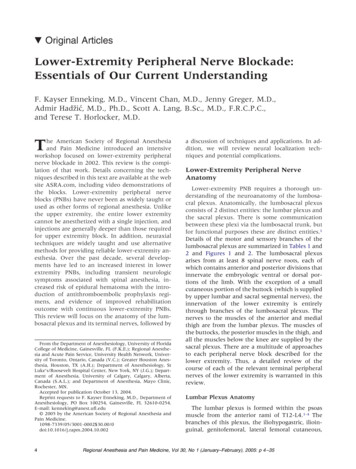
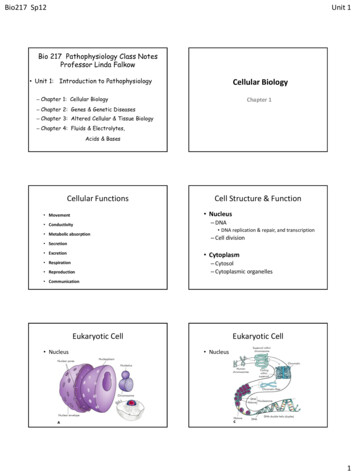
![Heart Failure Pathophysiology.ppt [Read-Only]](/img/29/card08-heartfailurebw.jpg)
